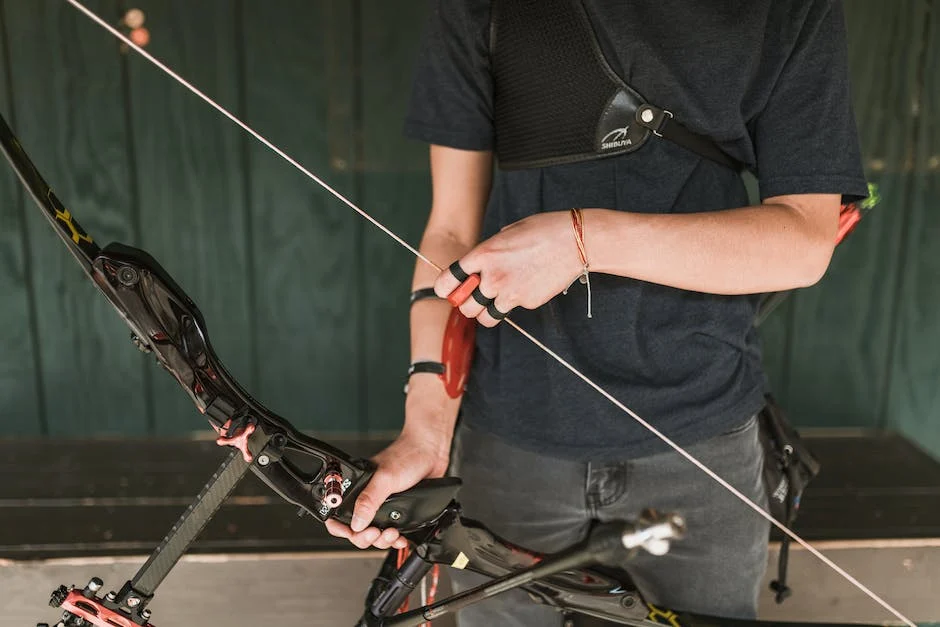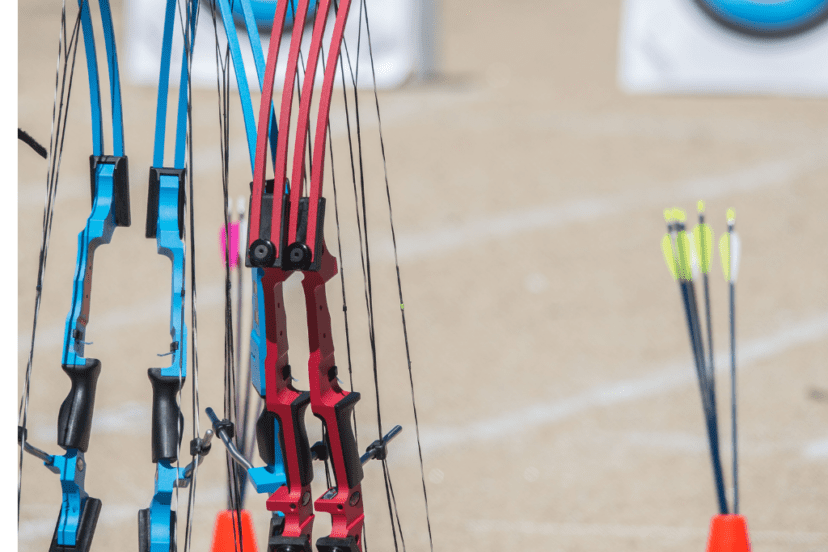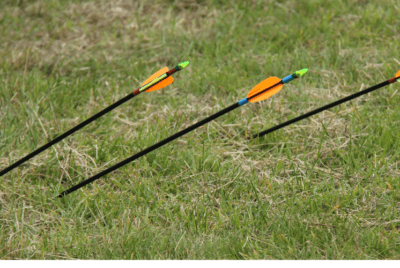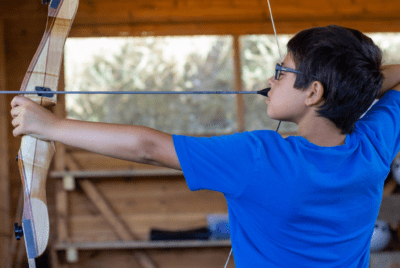Archery Equipment: An In-depth Look at What You Need
Introduction to archery equipment
When starting archery, it’s important to understand the basic equipment you’ll need. Here’s a quick overview of the essential gear:
- Bow: The main piece of equipment, available in various types such as recurve, compound, and traditional bows.
- Arrows: The ammunition for the bow, typically made of aluminum, carbon, or wood.
- Quiver: A container to hold arrows, available in different styles like hip, back, or bow-mounted quivers.
- Armguard: Protects your forearm from getting hit by the bowstring upon release.
- Finger tab or glove: Helps protect your fingers from getting hurt while releasing the bowstring.
- Bowstringer: An important tool for safely stringing and unstringing the bow.
Understanding these basic equipment pieces will help you get started in the world of archery.

Types of bows
Deciding on the right bow is crucial for any archery enthusiast. There are mainly four types of bows: compound, recurve, longbow, and crossbow. Each type has unique features and is suitable for different skill levels and purposes. Understanding the differences between these types will help you choose the perfect bow for your archery needs.
Different arrow types
Arrow types serve different purposes in archery. Here’s an overview of the various types available:
- Target Arrows: Designed for accuracy and consistency in target shooting.
- Hunting Arrows: Specifically made for hunting with features like broadheads for effective game penetration.
- Crossbow Bolts: Shorter and sturdier arrows designed for crossbows, with a flat nock to fit into the crossbow’s string mechanism.
Each type of arrow has specific characteristics tailored to its intended use, so it’s essential to choose the right type based on your individual archery needs.
Essential accessories for archery
When practicing archery, there are several essential accessories to consider. Some key elements include a bowstringer, which is used to safely string the bow; a finger tab or glove to protect your fingers while pulling the bowstring; armguards to prevent the bowstring from hitting your arm during release; and a quiver to hold your arrows. Additionally, a sight or scope can help improve accuracy, and bow stands offer a convenient way to hold your bow when not in use. Lastly, it’s important to have a proper case or bag to transport and protect your equipment.
Choosing the right equipment for beginners
If you are a beginner in archery, it is essential to choose the right equipment that suits your needs. Here are some key points to consider when selecting your archery gear:
- Start with a low-poundage bow to build your strength and form before moving on to higher poundage bows.
- Opt for a recurve bow as they are easier to maintain and typically recommended for beginners.
- Select arrows that are appropriate for your draw length and the type of shooting you intend to do, whether it is target practice or hunting.
- Invest in a comfortable and adjustable finger tab or glove to protect your fingers from the bowstring.
- Consider purchasing an armguard to prevent the bowstring from hitting your arm during the release.
- Get a quality bow sight to help improve your accuracy and aim.
These considerations will ensure that you have the right equipment to start your archery journey successfully.
Upgrading your archery equipment
Upgrading your archery equipment can improve your accuracy and overall performance. Here are some key points to consider when upgrading your gear:
- Upgrading your bow can enhance your shooting experience by providing better stability and accuracy.
- Investing in high-quality arrows can improve your consistency and precision.
- Upgrading your bow sight can help you aim more accurately, leading to better shot placement.
- Consider adding stabilizers to reduce bow vibration and improve your aim.
- Upgrading to a higher poundage release can provide smoother and more precise releases.
- Adding accessories such as bow quivers and arrow rests can enhance your shooting experience.
Maintenance and care for archery gear
Maintaining and caring for your archery gear is crucial to ensure its longevity and optimal performance. Here are some essential tips to keep your archery equipment in top condition:
- Regular Cleaning: Clean your bow, arrows, and other gear after each use to remove dirt, debris, and moisture. This helps prevent corrosion and damage.
- String Waxing: Regularly waxing your bowstring helps to protect it from wear and tear, ensuring a smooth release and preventing fraying.
- Inspect Your Equipment: Periodically inspect your bow, arrows, and other gear for any signs of damage or wear. Replace any worn-out or damaged components to maintain accuracy and safety.
- Proper Storage: Store your archery gear in a dry and secure location to prevent exposure to extreme temperatures, moisture, or sunlight, which can degrade the quality of the equipment.
By following these maintenance practices, you can prolong the life of your archery gear and enjoy consistent and accurate performance during your archery activities.
DIY solutions for archery equipment
If you’re interested in exploring DIY solutions for your archery equipment, there are several options you can consider to tailor your gear to your needs. Here are some straightforward ideas to get you started:
- Crafting your own bowstring using durable materials like paracord or dacron can be a cost-effective and rewarding choice. You can find tutorials online to guide you through the process.
- Creating your own arrow fletchings using feathers or synthetic materials can be a fun and customizable way to enhance your arrows’ accuracy and flight.
- Designing your own arrow rest using simple materials like adhesive-backed foam or leather can provide a personalized touch to your archery setup.
- Fashioning your own arm guard and finger tab from leather or other suitable materials can help protect and support your hands and arms while shooting.
These DIY solutions not only offer creative opportunities but also allow you to customize your equipment to fit your individual preferences and shooting style.
Importance of proper fitting and sizing
Ensuring your archery equipment fits properly is crucial for your comfort and success. Proper fitting and sizing can make a significant difference in your ability to aim accurately and consistently. A well-fitted bow and arrows will allow you to maintain proper form and technique, ultimately improving your performance. Additionally, a correctly sized bowstring will reduce the risk of injury and enhance your overall experience while practicing or competing.
Conclusion and summary
At the end of this guide, you should have a clear understanding of the essential equipment needed for archery. Make sure you have a reliable bow, quality arrows, and a properly fitting armguard and finger tab. Your choice of bow will depend on your strength and experience level, while your arrow selection should match your bow’s draw weight and length. Always prioritize safety and comfort when selecting your gear. With the proper equipment and regular practice, you will be well on your way to enjoying the sport of archery to its fullest.
FAQs for Archery Equipment Guide:
- Q: How do I choose the right bow for archery?
A: Your choice of bow depends on your strength and experience level. Beginners often start with a recurve bow, while those with more experience may prefer a compound or traditional bow. Consider factors like draw weight, length, and personal comfort when selecting a bow. - Q: What factors should I consider when selecting arrows for my bow?
A: When choosing arrows, match them to your bow’s draw weight and length. Additionally, consider the type of archery you’ll be doing (target, field, or hunting) and your skill level. Proper arrow selection is crucial for optimal performance and accuracy. - Q: Why is it important to have a properly fitting armguard and finger tab?
A: An armguard protects your forearm from the bowstring, preventing bruises and discomfort. A finger tab provides a smooth release, protecting your fingers from the pressure of the bowstring. Both are essential for safety and ensuring a comfortable and enjoyable archery experience. - Q: What are some safety considerations when choosing archery equipment?
A: Prioritize safety by ensuring your bow is properly maintained, arrows are in good condition, and all accessories are securely attached. Regularly inspect your equipment for wear and tear. Invest in quality gear, and follow proper archery safety guidelines to minimize the risk of accidents. - Q: How can I ensure a fulfilling archery experience through regular practice?
A: Regular practice is key to improving your archery skills. Set aside dedicated time for consistent practice sessions, focus on proper form, and gradually increase your shooting distance. Additionally, attend archery classes or seek guidance from experienced archers to enhance your technique and overall enjoyment of the sport.




